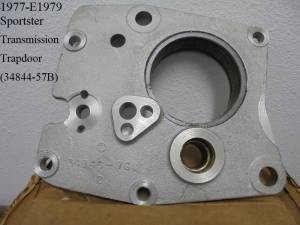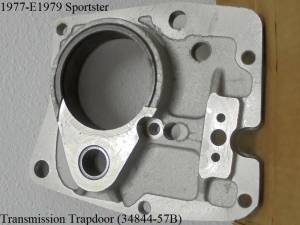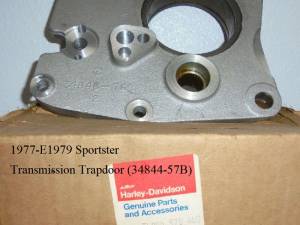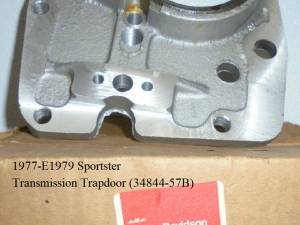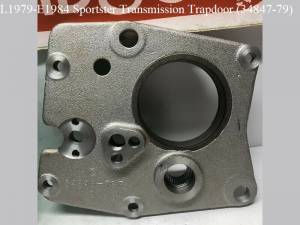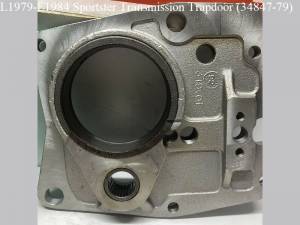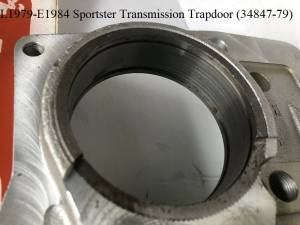Table of Contents
IH: Transmission & Final Drive - Sub-03F
1957-1985 Transmission Trapdoor Pics and Information
Transmission Trapdoor History
The first transmission door appeared in the mid 1954 model year. 1)
Previous to that you would have to split the cases to do any transmission repair. This was not popular with dealers.
The dealers were Harley Davidson's customers: It wasn't you and me. So what the dealers had to say had carried great weight with the Motor Company.
Transmission failures in the K models was a common occurrence. HD wood upgrade transmission changes almost immediately after the introduction of these models. These changes would continue until 1958. While Harley was trying to figure out how to keep these transmissions together, the dealers needed to be able to get into the transmissions to fix them. What that did is required HD to design and install what they called an access cover. We know it as the trans door.
The Japanese and Europeans would also adopt this access cover technology for the race bikes. They call them cassette transmissions. At the racetrack, you could now remove one transmission or replace it with another which meant gear ratio or transmission changes were quick and easy.
The mid 1954 through 1956 trans doors were attached to the cases via tapered dowel pins. This required hand fitting. Harley-Davidson must have been concerned that the trans door itself would become a issue and transmission failures. It didn't.
In 1957, the first interchangeable doors were introduced. Straight dowel pins. These doors remained unchanged until 1973. At that point the countershaft bearing area was reinforced.
In 1975, HD was in the process of swapping these bikes over to left hand shift if you if you look at a 77 and up model crankcase you'll see that the casting numbers are dash 75. For the 1977 model year the door was changed to accommodate the left hand shift shaft and the demise of the transfer valve. This door had the notch for the shifter shaft and a modification of the bottom profile of the door. The shifter shaft notches self-explanatory. The change to the bottom profile of the door was to allow the transmission and primary to share the oil. There is now a open area under the counter shaft were oil could migrate between the two compartments.
In 1977 when the door profile was changed, the crank cases were also changed. The area below the counter shaft drive gear in the crankcase was deepened: that changes the effective area open between the primary and the transmission.
Previous to this in 1976 and down models the transfer valve allowed the transmission to fill up with oil when the bike was idle. With your 1976 down bike, once the transfer valve evacuated most of the oil out of the primary, the trans remained basically isolated so the idea being that the trans kept getting lubed. Without the transfer valve in 1977, there was no need for this any longer it was actually thought that it was better off that the primary and trans shared the oil all the time. This is the door was supplied through the parts department as replacement for all 1957-up bikes. I've never found the problem with using these later doors on a 1976-down motorcycle. HD also used them on under XR's built after 1977.
Bottom line is that any sportster with a generator can interchange any generator vintage door on any generator vintage bike.
1977-E1979 Trapdoor
HD Part# (34844-57B)
Casting# (34846-76)
Machined cutout for left side shifter shaft protrusion.
1977-E1979 Sportster Transmission Trapdoor Pics:
Click on a pic to enlarge: 2)
L1979-E1984 Trapdoor
HD Part# (34847-79)
Casting# (34846-76F)
Machined cutout for left side shifter shaft protrusion.
L1979-E1984 Sportster Transmission Trapdoor Pics:
Click on a pic to enlarge: 3)
L1984 trapdoor (34847-84)
Used after July 26, 1984 beginning with crankcase #785 208001, will retrofit to all XL models with an alternator and utilizes two slots for removal. An alignment tool (SNAP-ON 1650) or (MAC LF-12) or equivalent in the shape of a crowbar is recommended by the MoCo to draw the access door from the dowel pins. You can use a propane torch to carefully apply heat to the access door dowel pin area. Do not allow flame to rest on any one area for a prolonged period of time and wipe all the oil from access door prior to heating. Insert the hook end into each slot and gently alternate between the slots to evenly remove the door from the dowel pins. 4) It was sold for parts order as a kit including a retaining ring (11006) for the mainshaft / fourth gear bearing assembly and four T-27 screws (2712). 5) The torx screws contained a thread locker in pellet form on the threads which, when the screw is started in the hole, breaks and releases the compound. As a result, the old screws could not be used. The stator is directly bolted to the door by the four torx locking screws at 30-40 in-lbs. The L84-85 stator (29966-84) 6) has 8 mounting holes with only four being used. To prevent possible chafing of the stator wire, you must use the proper holes when mounting the stator. Starting with the upper right set of holes (1-2) and numbering clockwise from 1-8, you must use holes number 1, 3, 6 & 7. The 85 stator (29967-84) 7) only has 4 holes. The mainshaft fourth gear bearing rests against a shelf in the trapdoor bore while the retaining ring sits in a groove in the door behind the bearing locking it in place. This beveled retaining ring is installed with the bevel side facing the transmission and the flat side facing the bearing.

